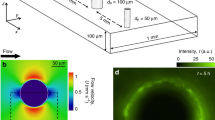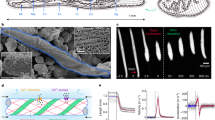Abstract
Multiple cell types sense fluid flow as an environmental cue. Flow can exert shear force (or stress) on cells, and the prevailing model is that biological flow sensing involves the measurement of shear force1,2. Here, we provide evidence for force-independent flow sensing in the bacterium Pseudomonas aeruginosa. A microfluidic-based transcriptomic approach enabled us to discover an operon of P. aeruginosa that is rapidly and robustly upregulated in response to flow. Using a single-cell reporter of this operon, which we name the flow-regulated operon (fro), we establish that P. aeruginosa dynamically tunes gene expression to flow intensity through a process we call rheosensing (as rheo- is Greek for flow). We further show that rheosensing occurs in multicellular biofilms, involves signalling through the alternative sigma factor FroR, and does not require known surface sensors. To directly test whether rheosensing measures force, we independently altered the two parameters that contribute to shear stress: shear rate and solution viscosity. Surprisingly, we discovered that rheosensing is sensitive to shear rate but not viscosity, indicating that rheosensing is a kinematic (force-independent) form of mechanosensing. Thus, our findings challenge the dominant belief that biological mechanosensing requires the measurement of forces.
This is a preview of subscription content, access via your institution
Access options
Access Nature and 54 other Nature Portfolio journals
Get Nature+, our best-value online-access subscription
$29.99 / 30 days
cancel any time
Subscribe to this journal
Receive 12 digital issues and online access to articles
$119.00 per year
only $9.92 per issue
Buy this article
- Purchase on Springer Link
- Instant access to full article PDF
Prices may be subject to local taxes which are calculated during checkout




Similar content being viewed by others
Data availability
The data supporting the findings of the study are available in this article and its Supplementary Information files. All of the RNA-Seq data used to reach the conclusions of this paper are freely available under the National Center for Biotechnology Information Sequence Read Archive accession number PRJNA530209. Additionally, the raw data that support the findings of this study are available from the corresponding author upon request.
Code availability
The custom MATLAB routines used for processing and analysing the fluorescence microscopy data are freely available from the corresponding author upon request. The custom Python and Perl scripts used for processing and analysing the RNA-Seq data are freely available from the corresponding author upon request.
References
Hansen, C. E., Qiu, Y., McCarty, O. J. T. & Lam, W. A. Platelet mechanotransduction. Annu. Rev. Biomed. Eng. 20, 253–275 (2018).
Vollrath, M. A., Kwan, K. Y. & Corey, D. P. The micromachinery of mechanotransduction in hair cells. Annu. Rev. Neurosci. 30, 339–365 (2007).
Persat, A. et al. The mechanical world of bacteria. Cell 5, 988–997 (2015).
Hughes, K. T. & Berg, H. C. The bacterium has landed. Science 358, 446–447 (2017).
Alsharif, G. et al. Host attachment and fluid shear are integrated into a mechanical signal regulating virulence in Escherichia coli O157:H7. Proc. Natl Acad. Sci. USA 17, 5503–5508 (2015).
Rodesney, C. A. et al. Mechanosensing of shear by Pseudomonas aeruginosa leads to increased levels of the cyclic-di-GMP signal initiating biofilm development. Proc. Natl Acad. Sci. USA 23, 5906–5911 (2017).
Drescher, K., Shen, Y., Bassler, B. L. & Stone, H. A. Biofilm streamers cause catastrophic disruption of flow with consequences for environmental and medical systems. Proc. Natl Acad. Sci. USA 11, 4345–4350 (2013).
Sakariassen, K. S., Orning, L. & Turitto, V. T. The impact of blood shear rate on arterial thrombus formation. Future Sci. OA 4, FSO30 (2015).
Gordon, A. et al. Single-cell quantification of molecules and rates using open-source microscope-based cytometry. Nat. Methods 2, 175–181 (2007).
Boechat, A. L., Kaihami, G. H., Politi, M. J., Lepine, F. & Baldini, R. L. A novel role for an ECF sigma factor in fatty acid biosynthesis and membrane fluidity in Pseudomonas aeruginosa. PLoS ONE 12, e84775 (2013).
Persat, A., Inclan, Y. F., Engel, J. N., Stone, H. A. & Gitai, Z. Type IV pili mechanochemically regulate virulence factors in Pseudomonas aeruginosa. Proc. Natl Acad. Sci. USA 24, 7563–7568 (2015).
Lee, C. K. et al. Multigenerational memory and adaptive adhesion in early bacterial biofilm communities. Proc. Natl Acad. Sci. USA 17, 4471–4476 (2018).
Inclan, Y. F. et al. A scaffold protein connects type IV pili with the Chp chemosensory system to mediate activation of virulence signaling in Pseudomonas aeruginosa. Mol. Microbiol. 4, 590–605 (2016).
Luo, Y. et al. A hierarchical cascade of second messengers regulates Pseudomonas aeruginosa surface behaviors. mBio 1, e02456-14 (2015).
Ellison, C. K. et al. Obstruction of pilus retraction stimulates bacterial surface sensing. Science 358, 535–538 (2017).
Siryaporn, A., Kuchma, S. L., O’Toole, G. A. & Gitai, Z. Surface attachment induces Pseudomonas aeruginosa virulence. Proc. Natl Acad. Sci. USA 47, 16860–16865 (2014).
Hug, I., Deshpande, S., Sprecher, K. S., Pfohl, T. & Jenal, U. Second messenger-mediated tactile response by a bacterial rotary motor. Science 358, 531–534 (2017).
McCarter, L., Hilmen, M. & Silverman, M. Flagellar dynamometer controls swarmer cell differentiation of V. parahaemolyticus. Cell 3, 345–351 (1988).
Brimer, C. D. & Montie, T. C. Cloning and comparison of fliC genes and identification of glycosylation in the flagellin of Pseudomonas aeruginosa a-type strains. J. Bacteriol. 12, 3209–3217 (1998).
Siryaporn, A., Kim, M. K., Shen, Y., Stone, H. A. & Gitai, Z. Colonization, competition, and dispersal of pathogens in fluid flow networks. Curr. Biol. 9, 1201–1207 (2015).
Chen, S. & Springer, T. A. Selectin receptor-ligand bonds: formation limited by shear rate and dissociation governed by the Bell model. Proc. Natl Acad. Sci. USA 3, 950–955 (2001).
Martinez, V. A. et al. Flagellated bacterial motility in polymer solutions. Proc. Natl Acad. Sci. USA 50, 17771–17776 (2014).
Potvin, E. et al. In vivo functional genomics of Pseudomonas aeruginosa for high-throughput screening of new virulence factors and antibacterial targets. Environ. Microbiol. 12, 1294–1308 (2003).
Skurnik, D. et al. A comprehensive analysis of in vitro and in vivo genetic fitness of Pseudomonas aeruginosa using high-throughput sequencing of transposon libraries. PLoS Pathog. 9, e1003582 (2013).
Cornforth, D. M. et al. Pseudomonas aeruginosa transcriptome during human infection. Proc. Natl Acad. Sci. USA 22, E5125–E5134 (2018).
Kim, M. K., Ingremeau, F., Zhao, A., Bassler, B. L. & Stone, H. A. Local and global consequences of flow on bacterial quorum sensing. Nat. Microbiol. 1, 15005 (2016).
Helmann, J. D. The extracytoplasmic function (ECF) sigma factors. Adv. Microb. Physiol. 46, 47–110 (2002).
Lesic, B. & Rahme, L. G. Use of the lambda Red recombinase system to rapidly generate mutants in Pseudomonas aeruginosa. BMC Mol. Biol. 9, 20 (2008).
Choi, K. H. & Schweizer, H. P. mini-Tn7 insertion in bacteria with single attTn7 sites: example Pseudomonas aeruginosa. Nat. Protoc. 1, 153–161 (2006).
Hoang, T. T., Kutchma, A. J., Becher, A. & Schweizer, H. P. Integration-proficient plasmids for Pseudomonas aeruginosa: site-specific integration and use for engineering of reporter and expression strains. Plasmid 43, 59–72 (2000).
Langmead, B. & Salzberg, S. L. Fast gapped-read alignment with Bowtie 2. Nat. Methods 9, 357–359 (2012).
Koch, M. D. & Shaevitz, J. W. Introduction to optical tweezers. Methods Mol. Biol. 1486, 3–24 (2017).
Acknowledgements
We thank K. Kim for assistance with generating the flow-shielded and biofilm streamer microfluidic channels. We also thank members of the Gitai laboratory, J. Shaevitz, N. Wingreen, D. Kearns and L. Wiltbank for helpful discussions and comments on the manuscript. This work was supported by a grant (DP1AI124669) from the National Institutes of Health (to Z.G.). Additional funding came from the National Science Foundation (PHY-1734030 to B.P.B. and M.D.K.), Glenn for Aging Research (B.P.B.), DFG award KO5239/1-1 from the German Research Foundation (to M.D.K.), and National Institutes of Health grants K22AI112816 (to A.S.) and R21AI121828 (to B.P.B. and M.D.K.).
Author information
Authors and Affiliations
Contributions
J.E.S., A.L., M.D.K., A.S., H.A.S. and Z.G. designed the experiments. J.E.S., A.L., M.D.K. and A.S. performed the experiments. B.P.B. and A.S. conducted the computational analyses. J.E.S. and Z.G. wrote the paper.
Corresponding author
Ethics declarations
Competing interests
The authors declare no competing interests.
Additional information
Publisher’s note: Springer Nature remains neutral with regard to jurisdictional claims in published maps and institutional affiliations.
Supplementary information
Supplementary Information
Supplementary Figures 1–11, Supplementary Tables 3–5 and Supplementary References.
Supplementary Dataset 1
Genes induced greater than threefold after four hours of flow.
Supplementary Dataset 2
Genes induced greater than threefold after 20 min of flow.
Rights and permissions
About this article
Cite this article
Sanfilippo, J.E., Lorestani, A., Koch, M.D. et al. Microfluidic-based transcriptomics reveal force-independent bacterial rheosensing. Nat Microbiol 4, 1274–1281 (2019). https://doi.org/10.1038/s41564-019-0455-0
Received:
Accepted:
Published:
Issue Date:
DOI: https://doi.org/10.1038/s41564-019-0455-0
This article is cited by
-
The accumulation and growth of Pseudomonas aeruginosa on surfaces is modulated by surface mechanics via cyclic-di-GMP signaling
npj Biofilms and Microbiomes (2023)
-
The role of shear dynamics in biofilm formation
npj Biofilms and Microbiomes (2022)
-
Microfluidic dose–response platform to track the dynamics of drug response in single mycobacterial cells
Scientific Reports (2022)
-
Mechanomicrobiology: how bacteria sense and respond to forces
Nature Reviews Microbiology (2020)
-
Go with the flow
Nature Reviews Microbiology (2019)



